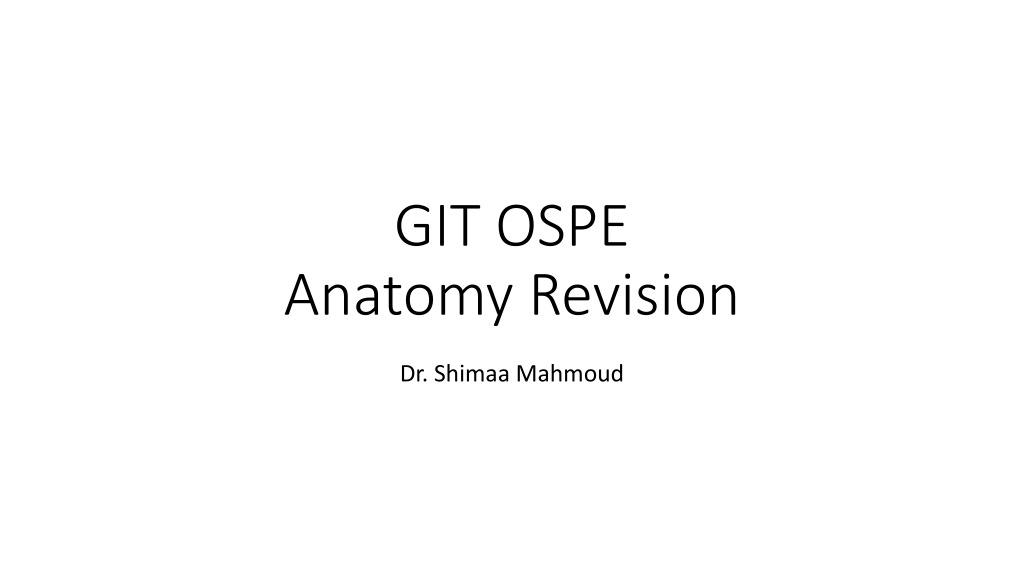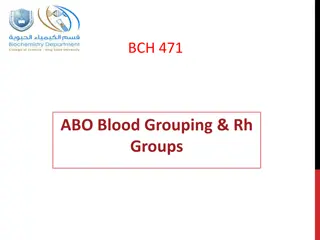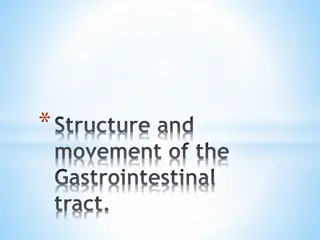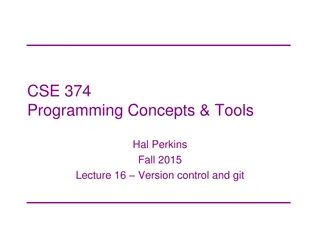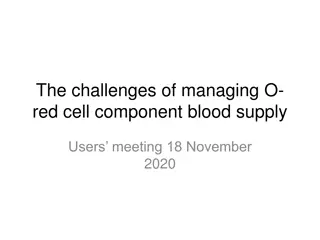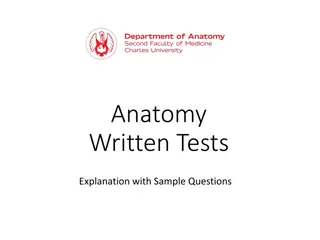Detailed Anatomy Review for GIT Blood Supply
This content provides a thorough anatomy revision focusing on the blood supply of the gastrointestinal tract (GIT). It covers stations discussing the blood supply of the stomach, complications during cholecystectomy, perforated duodenal ulcer scenarios, pancreatic tumors, and structures related to marked areas in the abdomen. Detailed information on arterial origins, organ associations, surgical scenarios, and anatomical relationships are explored with accompanying images.
Download Presentation

Please find below an Image/Link to download the presentation.
The content on the website is provided AS IS for your information and personal use only. It may not be sold, licensed, or shared on other websites without obtaining consent from the author. Download presentation by click this link. If you encounter any issues during the download, it is possible that the publisher has removed the file from their server.
E N D
Presentation Transcript
GIT OSPE Anatomy Revision Dr. Shimaa Mahmoud
Blood supply of GIT Blood supply of GIT
Station One A List blood supply of the stomach. 1. Left gastric. 2. Right gastric. 3. Left gastroepiploic. 4. Right gastroepiploic. 5. Short gastric Structures forming stomach bed (posterior relations) 1. Lesser sac 2. Left crus of diaphragm. 3. Left suprarenal gland 4. left kidney. 5. Spleen 6. Splenic artery. 7. Pancreas 8. Transverse mesocolon. Blood supply of (A) Left gastric artery from coeliac trunk Enumerate structures running in the lesser omentum along the lesser curvature of the stomach. 1. Right gastric vessels 2. Left gastric vessels
Station Two During cholecystectomy a resident damaged the cystic artery before the clamp was properly placed. The assistant surgeon applied pressure on top of the free margin of the lesser omentum to stop the bleeding. Identify 1. Stomach 2. Descending colon 3. Gallbladder 4. Root of mesentery 5. Ascending colon 6. Sigmoid colon 7. Teniae coli Blood supply of (3) and its origin? Cystic artery from Right hepatic artery of coeliac trunk
Station Three A 57-year-old male brought to the ER where he diagnosed with perforated duodenal ulcer in the posterior wall of the first part of the duodenum. Which artery lies behind the ulcer in his case? Gastroduodenal artery Enumerate 3 different organs supplied by this artery. stomach duodenum pancreas Identify: 1. 2. 3. 4. 5. Accessory pancreatic duct Minor duodenal papilla Major duodenal papilla Bile duct Main pancreatic duct
A 48-year-old man has lost 10 kilos over the last 3 months and presented with upper abdominal pain that radiates to the back between the scapulae. During examination the doctor noticed jaundice. CT scan reveals tumor of the head of the head of the pancreas. List the arterial supply of the pancreas and its origin 1. Superior pancreaticoduodenal artery: from gastroduodenal branch of hepatic artery of celiac 2. Inferior pancreaticoduodenal artery: from superior mesenteric artery 3. Splenic artery: from coeliac trunk Where does the main pancreatic duct open? Major duodenal papilla in the 2nd part of the duodenum Structures passing posterior to the head of the pancreas 1. IVC 2. Lower part of bile duct
Station Four What Are The Structures Related To Marked Areas 1. Gastric (Fundus Of Stomach) 2. Abdominal Part Of Esophagus 2 4 3. Duodenum 4. Right Suprarenal Gland 5. Right Colic Flexure 3 6. Right Kidney Mention the peritoneal folds of liver o Falciform ligament o Right triangular ligament o Left triangular ligament o Coronary ligament o Lesser omentum
Identify A C A. caudate lobe B. Fundus of gall bladder C. Inferior Vena Cava D. Porta hepatis What is the surface anatomy of (B) Fundus corresponds to the tip of the right 9th costal cartilage Mention the contents of (D) o Right and left hepatic ducts o Right and left branches of the hepatic artery o Right and left branches of the portal vein D B
Station Five Identify The Structures Related To Marked Areas A. Colic (left colic flexure) B. Renal (left kidney) C. Gastric (stomach) C D. Pancreatic (tail of pancreas) Enumerate The Ligaments Attaches To This Organ And Mention Its Contents B D A 1. Gastrosplenic ligament: short gastric and left gastroepiploic vessels. 2. Lienorenal (splenorenal) ligament: splenic vessels and the tail of pancreas.
Station Six Identify Right colic (hepatic) flexure Ascending colon Ileocecal junction Appendix Left colic (splenic) flexure Appendices epiploica Taenia coli Mention the anterior relations of (H) Greater omentum. Anterior abdominal wall H
Station Seven Identify (A) Abdominal part of esophagus Posterior relations of (A) Left crus of the diaphragm Sites of normal constrictions of this organ 1. At the pharyngeoesophageal junction 2. Where it is crossed anteriorly by the aortic arch and the left main bronchus 1. At esophageal hiatus where it passes through the diaphragm to join stomach The level of the esophageal opening of the diaphragm T10 A
Station Eight Station Eight A 12 year old boy is brought to the ER with a fever, nausea, and abdominal pain. Investigation revealed leucocytosis. The case is diagnosed as acute appendicitis. Identify the positions of the appendix: Retrocecal Subcecal Pelvic Postileal Preileal Which artery we need to be ligate during appendectomy? Appendicular artery From where does this artery arise? Ileocolic of superior mesenteric artery
Station Nine Station Nine Identify 1. Right lobe of liver 2. Right and left hepatic ducts 3. Common hepatic duct 4. Cystic duct 5. Uncinate process of head of pancreas 6. Second (descending) part of duodenum Mention the vertebral level of (6) L1 to L3 Mention the anterior relations of (6) Liver Transverse colon Small intestine 2 1 4 3 6 5
Station Ten 1. Liver 2. Spleen 3. Stomach 4. Gall bladder 5. Portal vein 6. IVC 7. Abdominal aorta 8. Lesser omentum 9. Lesser sac 10. Epiploic foramen
THANK YOU THANK YOU good luck good luck
